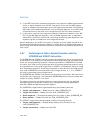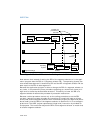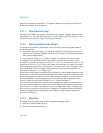
Vol. 3 5-37
PROTECTION
destination register and sets the ZF flag in the EFLAGS register. If the segment
selector is not visible at the current privilege level or is an invalid type for the LSL
instruction, the instruction does not modify the destination register and clears
the ZF flag.
Once loaded in the destination register, software can compare the segment limit with
the offset of a pointer.
5.10.4 Checking Caller Access Privileges (ARPL Instruction)
The requestor’s privilege level (RPL) field of a segment selector is intended to carry
the privilege level of a calling procedure (the calling procedure’s CPL) to a called
procedure. The called procedure then uses the RPL to determine if access to a
segment is allowed. The RPL is said to “weaken” the privilege level of the called
procedure to that of the RPL.
Operating-system procedures typically use the RPL to prevent less privileged appli-
cation programs from accessing data located in more privileged segments. When an
operating-system procedure (the called procedure) receives a segment selector from
an application program (the calling procedure), it sets the segment selector’s RPL to
the privilege level of the calling procedure. Then, when the operating system uses
the segment selector to access its associated segment, the processor performs priv
-
ilege checks using the calling procedure’s privilege level (stored in the RPL) rather
than the numerically lower privilege level (the CPL) of the operating-system proce-
dure. The RPL thus insures that the operating system does not access a segment on
behalf of an application program unless that program itself has access to the
segment.
Figure 5-15 shows an example of how the processor uses the RPL field. In this
example, an application program (located in code segment A) possesses a segment
selector (segment selector D1) that points to a privileged data structure (that is, a
data structure located in a data segment D at privilege level 0).
The application program cannot access data segment D, because it does not have
sufficient privilege, but the operating system (located in code segment C) can. So, in
an attempt to access data segment D, the application program executes a call to the
operating system and passes segment selector D1 to the operating system as a
parameter on the stack. Before passing the segment selector, the (well behaved)
application program sets the RPL of the segment selector to its current privilege level
(which in this example is 3). If the operating system attempts to access data
segment D using segment selector D1, the processor compares the CPL (which is
now 0 following the call), the RPL of segment selector D1, and the DPL of data
segment D (which is 0). Since the RPL is greater than the DPL, access to data
segment D is denied. The processor’s protection mechanism thus protects data
segment D from access by the operating system, because application program’s priv
-
ilege level (represented by the RPL of segment selector B) is greater than the DPL of
data segment D.


















